The Best New York Style Pizza Dough and 14 Tips for Success!!
I’ve been making a lot of this NY style pizza dough recipe …. The obsession started a while back, and I’ve finally found a recipe that I love the best! After years of experiments (and I mean years!), I am now using this recipe based on recommendations from the many fine pizza makers at www.pizzamaking.com and the late great Dough Doctor, Tom Lehmann.

Making Pizza Dough at Home
Making NY style pizza dough is definitely somewhat of an art form. There are so many variables that can be changed aside from the ingredients alone. For example, these variables include:
- oven temperature
- temperature of the water used to make the dough
- proofing methods (room temp vs cold rise)
- order of adding the ingredients (yes, this makes a big difference!)
- mixing time
- use of autolyse
- use of poolish (I don’t do this or the one before, although I have in the past)
And then of course, the toppings which can be simple or as complex as you’d like. But don’t worry too much about all of this – my method is easy and straightforward. Plus, you will make better dough than 99% of the pizza chains out there. You will not want take out anymore!
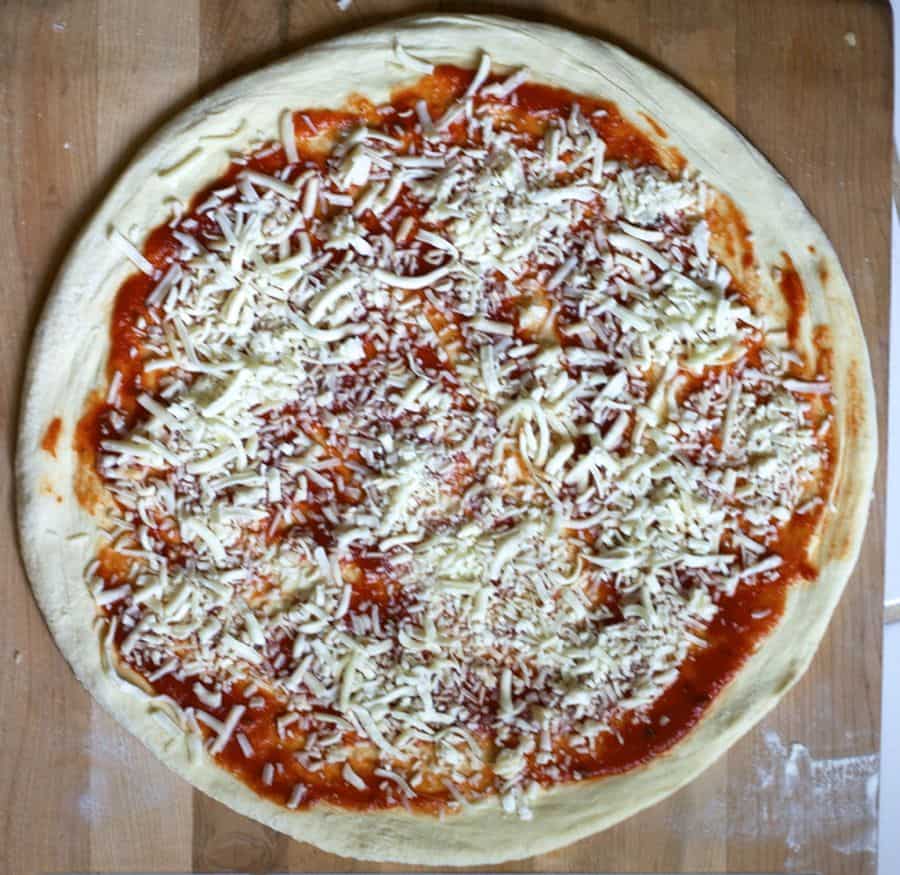
My Favorite Pizza Dough: The Big Secret (How You Proof the Dough)
My all-time favorite dough is NY style dough, which really is classic pizza dough that is stretched out into a thin crust pizza. This type of pizza dough contains water, flour, salt, instant yeast, and olive oil (and sugar especially when baking in a home oven, to help browning).
After it is mixed, it is proofed (left to rise/ferment) in the refrigerator for a minimum of 24 hours and up to 72 hours (it can also be frozen) – this is the big secret. I’ve used the dough up to 5 or 6 days afterwards, so you can essentially prepare dough for the week.
This recipe produces a crisp yet foldable crust that is tender, light, and flavorful and will make enough for four 14-inch pizzas. You can easily double or half the recipe to make 2 or 8 pizzas.

Fourteen Tips for Success
Tip 1: Choosing the flour
Use high-quality flour – I like to use King Arthur’s all purpose or bread flour; higher protein (ie, bread) flours work best. However, I prefer all-purpose flour because I like a lighter, airy crust.
Tip 2: Adding the yeast
Do not add instant dry yeast (IDY) directly to cold or cool water – you may shock the yeast (add the IDY to your flour instead) (please note that IDY differs from active dry yeast, which must be activated by adding it to water).
Tip 3: How much yeast?
Use only enough yeast to “get the job done” – yeast eats the sugar in your flour to produce its leavening effects – I find that if you use too much, your dough will be tasteless (this is just my opinion); however, it is a fact, that too much yeast can make your dough taste bad. Most recipes out there, some of them in well known, published books contain too much yeast!
Tip 4: Cold ferment that pizza dough!
Always use your refrigerator. The best NY style doughs “ferment” or “cure” in the refrigerator for at least 24 hours and up to 48 72 hours. This is called a “cold rise” (vs warm rise on your kitchen counter).
The refrigerator is used to retard (or slow) the dough’s fermentation, allowing that distinctive flavor to come through (ever wonder why some pizza crust tastes different than others, despite the fact that they are both made from just about the same exact ingredients? – this is a big reason why!)
When your dough rises too quickly, the flavor will not develop optimally. Slow rise = MUCH better flavor.
Tip 5: Weigh those ingredients!
Use a scale to weigh the flour instead of using a measuring cup – it is much more accurate and will yield superior results. I’ll admit, I resisted doing this for a loooong time. Just do it. You’ll be glad you did and your dough will be more consistent and much improved.
Tip 6: Add oil last
Mix the oil in as the last step, after the flour has all been incorporated. This is important to allow the flour to hydrate properly.
Tip 7: Flour your dough balls
Before tossing or opening your dough balls, flour them *very* well on each side (if you are a beginner) to ensure they do not stick to your counter or pizza peel. I sometimes use a bit more flour after I begin spreading them.
Tip 8: Keeping those rims a bit puffy
Take care not to “degas” the rim of your pizza as you are spreading your dough! Do NOT ever use a rolling pin! There are many different methods to spread/open your dough ball. I hope to add a few pictures someday of this process.
Tip 9: Baking pizza in a home oven
Ensure that your oven is preheated for a sufficient amount of time (about 1 hour) and bake the pizza within 6 to 8 inches of the top of your oven (ie, your broiler) so that the tops browns sufficiently in conjunction with the bottom of the pizza.
Do not place the stone near the bottom of your oven. I made this mistake for too many years.
After your stone has been preheated sufficiently, the heat from the stone will cook the pizza from the bottom and you can switch the broiler on if you find you need more browning on the top (I now use the broiler to bake my pizzas…more on this sometime in the future).
If you find that your cheese is browning well before your rim attains sufficient color, use partially frozen cheese (ie, place shredded cheese in the freezer while the oven is heating up) and cold sauce or you can drizzle just a bit of olive oil on top of cheese.
Tip 10: Use a pizza stone or steel
Use a pizza stone if you have one. The stone with draw moisture out of the dough and produce a beautifully crisp crust. I use a pizza steel because my stones kept breaking.
Tip 11: Use just the right amount of sauce
Do not use too much pizza sauce – it will make your pizza soggy
Tip 12: Find the right kind of cheese
Do not use low fat cheese to top your pizza or pre-shredded cheese (the former will not melt sufficiently and the latter contains additives that prevent the cheese from sticking together and therefore does not melt very well). The best is low-moisture, whole milk mozzarella.
If you must use pre-shredded cheese, I’ve found that adding the sauce on top of the cheese helps with the melting. Also, do not use too much cheese; apply it sparingly so that you can achieve that mottled NY pizza appearance.
Tip 13: Flour your pizza peel
Use semolina or flour on the bottom of your pizza peel to prevent the pizza dough from sticking but be careful not to overdo it because it will burn.
Tip 14: Learn to launch that pizza
Give the pizza peel a few very small quick jerks to make sure the pizza will easily slide off your pizza peel before attempting to transfer pizza to the oven, and more importantly, rub flour into the peel before placing the dough on top.
Essential Equipment
Please note that as an Amazon affiliate, we earn a small commission if you purchase a product at no additional cost to you.
I adore my baking steel; it’s transformed my home pizzas into restaurant-quality and better. You will love this! A kitchen scale streamlines measurement with remarkable accuracy, while a pizza peel is essential for smoothly sliding pizzas into the oven. And proofing boxes provide an optimal storage for pizza dough fermentation, enhancing flavor, texture, and elasticity.
Please visit our SHOP page for more recommended tools and equipment to make restaurant-style NY-style pizza at home!
How to Stretch the Pizza Dough
A nice video (from The GoodFellas Pizza School of NY), showing how to stretch the dough:

How to Freeze Homemade Pizza Dough
- After mixing dough and dividing into balls, place dough in refrigerator for at least 24 hours.
- Place dough balls on baking sheet lined with plastic wrap or parchment paper, cover loosely with plastic wrap and freeze until firm (~ 2 to 3 hours or up to overnight).
- Wrap frozen dough balls individually in plastic and store in zipper-lock bags for up to 4 weeks.
- When ready to bake, transfer unwrapped dough into the refrigerator for 12 to 24 hours before making pizza.
- Bring dough to room temperature for 20 to 60 minutes before baking (less time for hot kitchen/summer and more time for cool kitchen)
Pizza Dough Calculator
Need more dough? Less dough? Try out our new Pizza Dough Calculator to calculate the weights to get it just right!
Have More Questions?
Please See My NY Pizza FAQ
If you tried this recipe, please leave a 🌟 star rating and let me know how it went in the 📝 comments below! SUBSCRIBE for more recipes.
📖 Recipe

The Best New York Style Pizza Dough
Equipment
- pizza stone or pizza steel for baking
- Standing mixer optional or hand knead
- kitchen scale highly recommended instead of volume measures
Ingredients
Original Recipe for Four 14-Inch Pizzas; want to make more or less? Use the pizza dough calculator
- 6.5 cups (796 g) all purpose flour or bread flour (weighing is most accurate!)
- 2 1/4 cups (493 g) water barely cold water (17.4 oz per 2 1/4 cups)
- 1 teaspoon (3.5 g) instant dry yeast
- 2.5 teaspoons (15.6 g) salt
- 2 teaspoons (7.8 g) sugar
- 1 tablespoon (11.8 g) olive oil
1 Pound of Dough (~454 grams) (use the pizza dough calculator to make more or less dough)
- 2 1/4 cups (274.5 g) all purpose flour or bread flour
- 3/4 cup (170.2 g) water
- 1/2 teaspoon instant dry yeast
- 1 teaspoon salt
- 3/4 teaspoon sugar
- 1 teaspoon olive oil
Instructions
Mixing the Dough
- Place water in mixing bowl.
- In a separate bowl, mix salt and yeast (and sugar if using) into flour
- Combine flour/salt/yeast mixture into water and mix until all the flour has been incorporated.
- After flour has been totally incorporated, add oil and knead for about 4 to 5 minutes (see note)
- Test final dough temperature, which should ideally be between high 70s to low 80s (optional)
Dividing and Rising
- Divide dough into 4 equal pieces (using a digital scale if possible; each ball should weigh 11.5 oz [~326 grams]), shape into a ball, and place in greased, sealed quart-sized container or oiled/greased freezer bag and refrigerate overnight or up to 72 hours (After much experimenting, I have concluded that I like 3 days best but day 2 is good too).
Assembly and Baking
- The following day, remove your dough balls within 1 hour or less of baking and allow the dough to come to room temperature. (the dough will tend to blister more if the dough has not been allowed to come to room temperature however, I often bake coldish dough without problems, just some bubbling)
- In the meantime, place your pizza stone in oven and preheat at 550 degrees (depending on thickness of your stone and your oven’s power) for at least 1 hour
- Open each dough ball using care not to degas, transfer to a pre-floured pizza peel (or on parchment paper), and top with your favorite sauce, cheese, or other toppings.
- Transfer pizza from peel to oven or slide parchment paper onto preheated pizza pan/stone and bake for 4 to 6 minutes each until browned on top and cheese has melted but not burned.
- Enjoy!
Notes
- Use of weight based measurements is highly recommended instead of US Customary. You will need a kitchen scale.
- METRIC amounts DO NOT correspond exactly to the US Customary amounts because, for example, 796 grams equals 6.4 cups (and most can’t measure 0.4 cups or 0.22 cups). Recipe was based on grams.
- Use the Pizza Dough Calculator
- If you want to use the dough the next day, knead a little more (slow speed for about 8 to 10 minutes)
- If you have time to let the dough rest for 3 days, knead for 4 to 5 minutes, low speed or hand knead.
- After mixing dough and dividing into balls, place dough in refrigerator for at least 24 hours.
- Then, place on baking sheet lined with plastic wrap or parchment paper, cover loosely with plastic wrap and freeze until firm (~ 2 to 3 hours or up to overnight).
- Wrap frozen dough balls individually in plastic and store in zipper-lock bags to store for up to 4 weeks (longer may work, but results might vary).
- Before using, transfer unwrapped dough into the refrigerator for 12 to 24 hours before making pizza.
- Bring dough to room temperature for 20 to 60 minutes before baking (less time for hot kitchen/summer and more time for cool kitchen).
- calculate your own using baker’s percentages: 62% hydration, 0.4% yeast, 2% salt, 1.5% oil, and 1% sugar or use my new pizza dough calculator.
Nutrition
Try these other pizzas and this NY pizza sauce:
Buffalo style (one of my absolute favorites)
White with prosciutto
White with spinach and feta
Pizza sauce

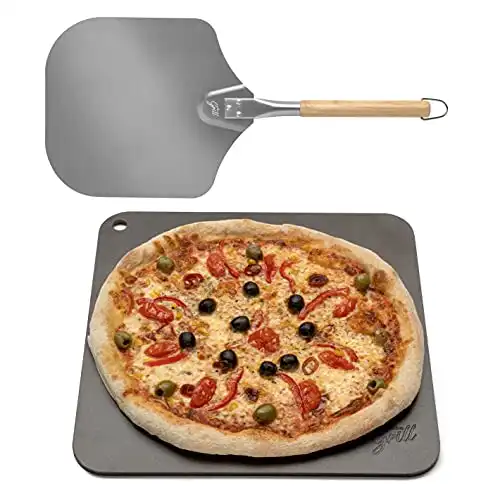
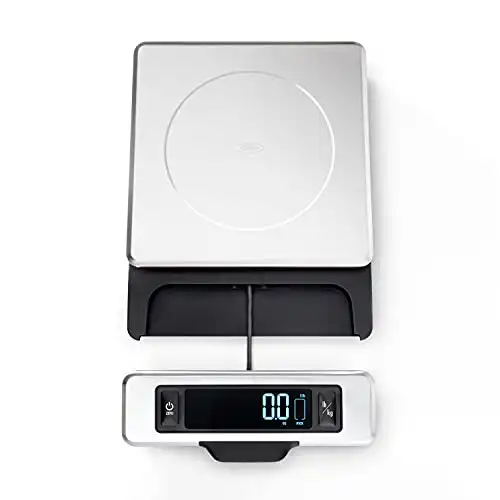
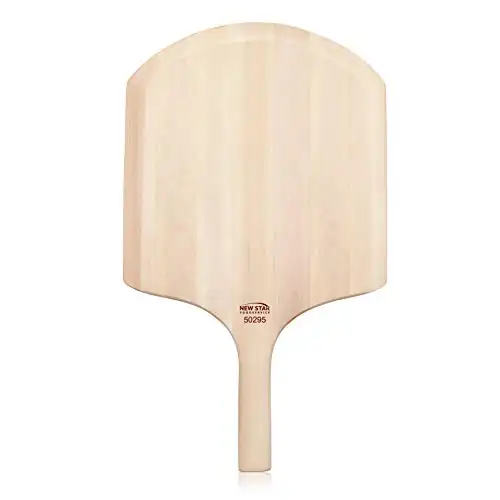
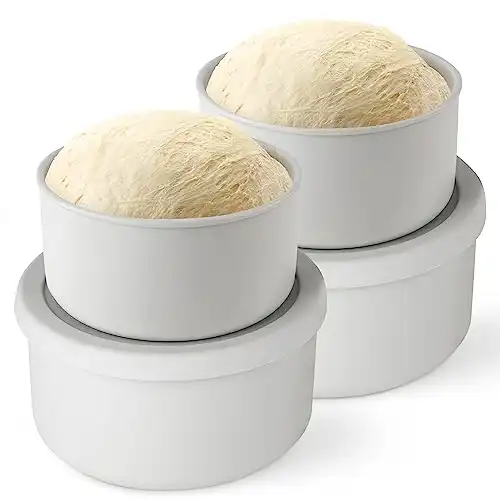
Hi,
Can freeze the entire piece of mozarella and shred it frozen and put on top of dough?
Is this the same thing of freezing the shreded cheese before topping?
Thanks
Sorry for the delay – I don’t think it would be feasible to shred a frozen piece of mozzarella. I would shred first then freeze or you can freeze the shredded stuff from the store.
You are right. The frozen mozzarela becomes to stiff to shred. Best to put in the fridge on the day before making the pizza.
Regards!
Amazing. By far the best I have ever made. This rivals any of the best pizza places I have had and in most cases blows them away. The video showing how to stretch the dough was incredibly helpful. THANK YOU!!!!
great! glad you like it
i dont have instant yeast easily available to me but i do have active dry yeast. could you please tell me how can i incorporate that into your recipe as i really want to try it! thanks 🙂
Oh Sanya, I’m so sorry for the late reply! See answer to question 2 in this link: http://redstaryeast.com/tips-troubleshooting/frequently-asked-questions/
I’d check online and search about the brand you are using. For Red Star, it’s a 1 to 1 conversion
I am having the same issues as “Jason” was having. When I measure out one cup of KA All Purpose flour it weighs 5.6 oz not 4.25 oz. My scale is working fine. (I work in chemistry so massing things on digital scales and using densities is something I do every day. Everything I weigh other than the flour comes out correct.) I have not actually made the recipe without using 6.5 cups yet. My new scale is on the way and I am going to make this based on grams. I also have a new stand mixer now, I’ll let you know how this comes out. (Kneading by hand before, the dough was always too sticky and never seemed to come together, hence me always adding to 6.5 cup flour, perhaps with the stand mixer I won’t have that issue.) I have tried this recipe compared to others on the net and this is the one I always come back too. I like that you don’t proof the yeast and you use less yeast, some how I think this makes a big difference, at least toward giving a taste I like. I am actually kind of excited to do the recipe and get the hydration closer to what you have intended. The cold rise is also THE way to go. It also helps the dough keep longer and lets you spread out when you make your pizzas, instead of having all your dough ready all at once when you do warm, quick rises.
Always go with weights over volume measurements – that way, you are getting the correct hydration. Enjoy!
Hi and greetings from Brazil!
I made this recipe and it is incredible!
Can you describe how do you bake it with the broiler method?
Thanks!
Hello! I preheat my pizza steel (or stone, whatver you use) for about 45 minutes on a rack within about 6 to 8 inches from the top of the oven. After I launch the pizza onto the stone, I switch on the broiler to cook the top while the heat from the stone or steel cooks the bottom. Sometimes I use cold sauce and frozen cheese so that the toppings do not burn before the crust is cooked. Unfortunately, even oven runs a little differently so you may have to play around to see what works for you
You say you use steel for your pizza because your stones keep breaking. You also say you broil your pizzas. The broiling is why your stones keep breaking. Using the broiler and/or cooking at temperatures above 450-475F will crack stoneware.
Good point, but I only began using the broiler method after I purchased the stone from what I remember (but it’s been a loooong time since I used a stone). The last stone that I bought was actually made for use in a kiln http://www.axner.com/cordierite-shelf-16x16x34square.aspx so I’d assume that the broiler heat wouldn’t have caused it to crack? I was perplexed because it is rated for firing temps up to 2200 degrees. But honestly, I don’t remember what happened – I may have dropped it, it may have been the temp changes? I dunno though because it did end up breaking and I haven’t looked back. I LOVE LOVE LOVE my pizza steel. The best thing is that if you live near a steel manufacturer you can get a precut size of 1/4″ steel for dirt cheap. Otherwise, you’d have to order it online and most of the cost is in the shipping but if you add up the cost of all the darn pizza stones that I’ve broken and all the “order out” money that I’ve saved, the pizza steel is a huge bargain IMO 🙂
Hi Marie,
Growing up in NJ in the 80s, most pizza joints would have the cheesy greasy orange oil folded pizza to die for. I think this might be close (not to suggest this is greasy or over cheesy). Point is, I now live in Maine and its either wood burning/brick oven pizza or chain pizza (yuck). No one here knows what NY pizza is. I’ve made grilled pizzas and used fire bricks on my gas grill to find a little peace of mind. Also the fresh buffalo cheese is is nice but not what I’m looking for. So, here are a few questions. 1. Can I use the fire bricks in the oven in place of the stone (how would you do this)? 2. Have you ever tried butter in the sauce? 3. I use corn syrup in some of my other bread recipes. Would this work in place of sugar? 4. For 2 1/2 cups of flour, is 1 pkg instant dry yeast too much?
Regards,
Al
Hi Alan! I know how you feel – we lived in the Midwest for a few years, and although I absolutely LOVED detroit pizza (especially Buddy’s!!), I did miss eating NY style pizza! I’ll try and answer your questions but I haven’t experimented enough to know how other options work, so I can’t speak about the firebricks or corn syrup. The sugar is only to get browning on your crust. The photo that is shown on my site is before I started adding a little sugar – sugar has really made a big difference in my home oven to get the dough browning well. I’ve never tried butter in the sauce but I sometimes drizzle a little olive oil. Try the butter and see how you like it…about the yeast, yes! that’s definitely too much. 1 pkg has about 2 1/4 teaspoons, and my recipe for ~6 cups flour uses only 1 teaspoon:) Back to the oven set up, if you live near a steel mfg, getting a precut 1/4″ plate is usually dirt cheap and will last forever! Good luck
This pizza dough was excellent!. I used my green egg grill!! It turned out to be the best pizza I ever cooked. I didn’t have the time to let it sit overnight. So I mede two pizza today after let the dough set fir 3-4 hours. The other two are still in the refrigator. I cant wait to made the other two using the rest of the dough
Great! I want a green egg too!
Active dry yeast yields a dough with more extensibility than instant yeast. I always use ADY for pizza dough.
Hi Kg – Interesting, I’d never heard of yeast affecting the extensibility of dough. I have heard people say that ADY yields a slower rise, with more flavor but given the cold rise of this recipe, either IDY or ADY will be slow. To increase extensibility, I use autolyze technique (for bread making) but I am going to play more attention to the ADY effect you describe.
What are your thoughts about me reducing the amount of water to do 65% hydration for Tipo 00 flour, but keeping everything else in your recipe the same? Will the dough come out alright?
**Correction, I meant increasing the water.
Hi David – I guess it depends on why you want to increase the water…I don’t have much experience with 00 flour. Also, I”m assuming that you know 00 flour comes in all types of protein content so please make sure the protein content is in the 12% range.
Because 00 flour is so finely milled it actually needs less water compared to traditional American flour so I would first try using the recipe as written. 00 flour is often used in Neapolitan pizza which is baked in a very hot brick oven (800 to 900 degrees) and so those doughs are much wetter because of the very high heat of the brick oven. Such a wet dough is not needed for NY pizza. hope this helps
Oh, and thanks for the recipe and great tips. I’m trying this one for sure!
What sauce do like on this? I’ve made super simple to super complex. I like to keep it simple but my wife prefers the more complex roasted tomato and vegetables sauce.
I have a pizza sauce recipe on this site that you might want to try. The most traditional NY pizza sauce is uncooked and lightly seasoned with any combination of salt, black pepper, oregano, garlic (fresh or dried), red pepper flakes, and onion powder. Drizzle of olive oil sometimes too. I’ve had Boardwalk pizza with a cooked pizza sauce and that’s good too! I don’t have a recipe for that though…
its an AP flour, that’s just the name of the company. As far as getting a hold of them asking protein content well that prob would not be so easy here lol I think i will remeasure the recipe to make sure there were no errors and use a different yeast. also i plan on wrapping it better to avoid condensation.
It’s possible I used a digital scale but there is always potential for error. the flour was a local flour here in the Dominican republic pasta princessa but I’m sure you probably not familiar with but they don’t really include a lot of info on there package so its hard to say. would the position in the frig effect it? I set it on the bottom, I’m wondering if its to cold. the only other factors I noticed would be the dough relaxers, water as you said, frig temp or I noticed the container i had the dough in had a lot of condensation when i opened it up a lot of water drips appeared to have falling in or around the dough while it was being fermenting. I will attempt process of elimination to fix the problem. If i cant find the instant yeast as the recipes calls for can I use active dry yeast with a substitution ratio? and will it affect flavor?
Hi Mark – the flour is the most important ingredient and if it is not suitable for bread it might be the cause. See if maybe you can call the manufacturer and ask how much protein is in the flour. It should be at least 11% or 12% and some like it even higher, like 14% but I think it can sometimes be too tough. I am wondering if you might be using durum or semolina flour since it is labeled pasta? It is white or yellowish? For the yeast, the active dry would be fine, and some actually prefer it because they say it helps the dough ferment more slowly
hey Marie great recipe but
I’m having some problems I used fletchmans pizza yeast which I think is an IDY but once I took out my dough after the first 24 hour trail is was so loose no body at all. I could not even get it to keep shape to form the crust. once I read the label of the yeast it said it contained dough relaxers and its meant to make a pizza after 30 min no proofing o rising needed. have you heard of this or think this could be the culprit for my no body pizza dough? I used a digital scale to weight my stuff out, so I’m pretty sure the measurements are good. I’m in the Dominican republican and i used a flour from here do you think it could be flour problem or hydration etc?
I’ve never heard of pizza yeast, but I am intrigued! What kind or brand of flour did you use? The dough should not be overly wet or droopy so something definitely not right..hard to say though without being there with you.
Being the pizza nerd that I am, I just called Fleishmans and they assured me that you could sub the pizza yeast for the instant yeast 1:1 but that there were dough relaxers like you said and they said that those dough relaxers would change the texture of the dough, but it shouldn’t make it too soft. Is it possible that there was a error in the measurement of water or oil (ie, too much)?